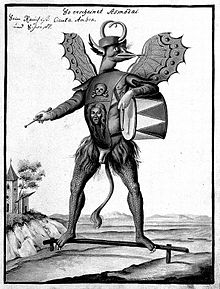Our website is made possible by displaying online advertisements to our visitors.
Please consider supporting us by disabling your ad blocker.
Shedim


35. And they mingled with the nations and learned their deeds. 36. They worshipped their idols, which became a snare for them. 37. They slaughtered their sons and daughters to the demons [(shedim)]. 38. They shed innocent blood, the blood of their sons and daughters whom they slaughtered to the idols of Canaan, and the land became polluted with the blood. 39. And they became unclean through their deeds, and they went astray with their acts.
17. They sacrificed to demons [(shedim)], which have no power, deities they did not know, new things that only recently came, which your forefathers did not fear.
Shedim (Hebrew: שֵׁדִים, romanized: šēḏim; singular: שֵׁד šēḏ)[3] are spirits or demons in the Tanakh and Jewish mythology. Shedim do not, however, correspond exactly to the modern conception of demons as evil entities as originated in Christianity.[4] While evil spirits were thought to cause maladies, shedim differed conceptually from evil spirits.[5] Shedim were not considered evil demigods, but the gods of foreigners; further, they were envisaged as evil only in the sense that they were not God.[6]
They appear only twice (and in both instances in the plural) in the Tanakh, at Psalm 106:37 and Deuteronomy 32:17. In both instances, the text deals with child sacrifice or animal sacrifice.[7][8] Although the word is traditionally derived from the root ŠWD (Hebrew: שוד shuḏ) that conveys the meaning of "acting with violence" or "laying waste,"[9] it was possibly a loanword from Akkadian, in which the word shedu referred to a spirit that could be either protective or malevolent.[10][11][12] With the translation of Hebrew texts into Greek, under the influence of Zoroastrian dualism, "shedim" was translated into Greek as daimonia with implicit connotations of negativity. Later, in Judeo-Islamic culture, shedim became the Hebrew word for the jinn, conveying the morally ambivalent attitude of these beings.[13]
- ^ The Complete Jewish Bible. Chabad.org.
- ^ The Complete Jewish Bible. Chabad.org.
- ^ Russell, J. B. (1987). The Devil: Perceptions of Evil from Antiquity to Primitive Christianity. Vereinigtes Königreich: Cornell University Press. p. 215
- ^ Dorian Gieseler Greenbaum. The Daimon in Hellenistic Astrology: Origins and Influence. BRILL, 2015. ISBN 9789004306219. p. 127.
- ^ Dorian Gieseler Greenbaum. The Daimon in Hellenistic Astrology: Origins and Influence. BRILL, 2015. ISBN 9789004306219. p. 128.
- ^ Benjamin W. McCraw, Robert Arp. Philosophical Approaches to Demonology. Routledge, 2017. ISBN 978-1-315-46675-0. p. 9.
- ^ W. Gunther Plaut, The Torah: A Modern Commentary (Union for Reform Judaism, 2005), p. 1403 online
- ^ Dan Burton and David Grandy, Magic, Mystery, and Science: The Occult in Western Civilization (Indiana University Press, 2003), p. 120 online.
- ^ "Old Testament Hebrew Entry for Strong's #7700 - שֵׁד". BlueLetterBible.org. Retrieved 8 March 2019.
- ^ Rachel Elior; Peter Schäfer (2005). על בריאה ועל יצירה במחשבה היהודית: ספר היובל לכבודו של יוסף דן במלאת לו שבעים שנה. Mohr Siebeck. p. 29. ISBN 978-3-16-148714-9.
- ^ Encyclopedia of Spirits: The Ultimate Guide to the Magic of Fairies, Genies, Demons, Ghosts, Gods & Goddesses. Judika Illes. HarperCollins, Jan 2009. p. 902.
- ^ The Encyclopedia of Demons and Demonology. Rosemary Guiley. Infobase Publishing, May 12, 2010. p. 21.
- ^ Jan Dirk Blom, Iris E. C. Sommer. Hallucinations: Research and Practice. Springer Science & Business Media, 2011. ISBN 978-1-461-40958-8. p. 237.
Previous Page Next Page


